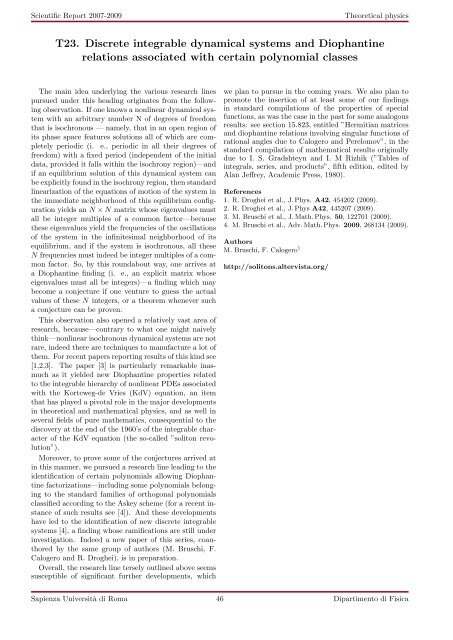download report - Sapienza
download report - Sapienza
download report - Sapienza
Create successful ePaper yourself
Turn your PDF publications into a flip-book with our unique Google optimized e-Paper software.
Scientific Report 2007-2009<br />
Theoretical physics<br />
T23. Discrete integrable dynamical systems and Diophantine<br />
relations associated with certain polynomial classes<br />
The main idea underlying the various research lines<br />
pursued under this heading originates from the following<br />
observation. If one knows a nonlinear dynamical system<br />
with an arbitrary number N of degrees of freedom<br />
that is isochronous — namely, that in an open region of<br />
its phase space features solutions all of which are completely<br />
periodic (i. e., periodic in all their degrees of<br />
freedom) with a fixed period (independent of the initial<br />
data, provided it falls within the isochrony region)—and<br />
if an equilibrium solution of this dynamical system can<br />
be explicitly found in the isochrony region, then standard<br />
linearization of the equations of motion of the system in<br />
the immediate neighborhood of this equilibrium configuration<br />
yields an N × N matrix whose eigenvalues must<br />
all be integer multiples of a common factor—because<br />
these eigenvalues yield the frequencies of the oscillations<br />
of the system in the infinitesimal neighborhood of its<br />
equilibrium, and if the system is isochronous, all these<br />
N frequencies must indeed be integer multiples of a common<br />
factor. So, by this roundabout way, one arrives at<br />
a Diophantine finding (i. e., an explicit matrix whose<br />
eigenvalues must all be integers)—a finding which may<br />
become a conjecture if one venture to guess the actual<br />
values of these N integers, or a theorem whenever such<br />
a conjecture can be proven.<br />
This observation also opened a relatively vast area of<br />
research, because—contrary to what one might naively<br />
think—nonlinear isochronous dynamical systems are not<br />
rare, indeed there are techniques to manufacture a lot of<br />
them. For recent papers <strong>report</strong>ing results of this kind see<br />
[1,2,3]. The paper [3] is particularly remarkable inasmuch<br />
as it yielded new Diophantine properties related<br />
to the integrable hierarchy of nonlinear PDEs associated<br />
with the Korteweg-de Vries (KdV) equation, an item<br />
that has played a pivotal role in the major developments<br />
in theoretical and mathematical physics, and as well in<br />
several fields of pure mathematics, consequential to the<br />
discovery at the end of the 1960’s of the integrable character<br />
of the KdV equation (the so-called ”soliton revolution”).<br />
Moreover, to prove some of the conjectures arrived at<br />
in this manner, we pursued a research line leading to the<br />
identification of certain polynomials allowing Diophantine<br />
factorizations—including some polynomials belonging<br />
to the standard families of orthogonal polynomials<br />
classified according to the Askey scheme (for a recent instance<br />
of such results see [4]). And these developments<br />
have led to the identification of new discrete integrable<br />
systems [4], a finding whose ramifications are still under<br />
investigation. Indeed a new paper of this series, coauthored<br />
by the same group of authors (M. Bruschi, F.<br />
Calogero and R. Droghei), is in preparation.<br />
Overall, the research line tersely outlined above seems<br />
susceptible of significant further developments, which<br />
we plan to pursue in the coming years. We also plan to<br />
promote the insertion of at least some of our findings<br />
in standard compilations of the properties of special<br />
functions, as was the case in the past for some analogous<br />
results: see section 15.823, entitled ”Hermitian matrices<br />
and diophantine relations involving singular functions of<br />
rational angles due to Calogero and Perelomov”, in the<br />
standard compilation of mathematical results originally<br />
due to I. S. Gradshteyn and I. M Rizhik (”Tables of<br />
integrals, series, and products”, fifth edition, edited by<br />
Alan Jeffrey, Academic Press, 1980).<br />
References<br />
1. R. Droghei et al., J. Phys. A42, 454202 (2009).<br />
2. R. Droghei et al., J. Phys A42, 445207 (2009).<br />
3. M. Bruschi et al., J. Math. Phys. 50, 122701 (2009).<br />
4. M. Bruschi et al., Adv. Math. Phys. 2009, 268134 (2009).<br />
Authors<br />
M. Bruschi, F. Calogero 1<br />
http://solitons.altervista.org/<br />
<strong>Sapienza</strong> Università di Roma 46 Dipartimento di Fisica

















